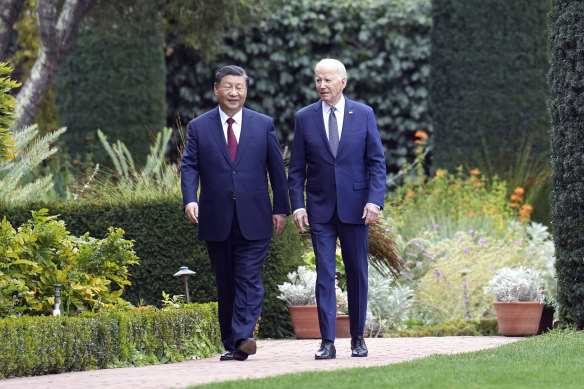
Save articles for later
Add articles to your saved list and come back to them any time.
San Francisco: Joe Biden and Xi Jinping entered their high-stakes meeting on the sidelines of APEC with a long list of contentious issues to discuss, limited room for compromise and a shared desire to stabilise an increasingly fraught relationship.
After four hours, the pair emerged with modest but important gains, signalling the potential start of a recalibration in US-China relations.
Traversing well-trodden ground. Joe Biden and Xi Jinping.Credit: AP
They agreed to address the flow of precursor chemicals from China that are used to manufacture fentanyl, which is now America’s deadliest illicit substance.
They will work together to examine the risks and benefits of AI, although US officials acknowledge this is a process that will require much more dialogue before concrete steps can be taken.
And in terms of military communication between their armed forces – which essentially stopped after then House Speaker Nancy Pelosi defied China and visited Taiwan last year – the countries vowed to resume contact, minimising the risk of “accidents” in navigational waters or skies.
For Biden, this was arguably the biggest win from the meeting.
After all, the US views “military to military” communication as crucial to any missteps that could result in a full-blown conflict, particularly across the Asia-Pacific, where China has ramped up its efforts to militarise man-made islands in the South China Sea, and a series of near-misses between US and Chinese ships and aircraft have exacerbated tensions between the two countries.
Now, military contact will finally resume: from policy-level discussions involving Defence Secretary Lloyd Austin and his Chinese counterpart, to operational engagements involving US and Chinese military commanders, ship drivers and others.
Biden described the gathering as one of the most “constructive and productive discussions” he’s had with Xi – although he almost undid the pair’s progress when he ended a press conference saying that he still views his Chinese counterpart as a “dictator”.
The question is: How much of these commitments will stick, and how much can China be trusted to keep to its word?
“The summit yielded some positive outcomes, although whether they produce real progress in narrowing differences remains to be seen,” says China expert Bonnie Glaser, the director of the Asia Program at the German Marshall Fund.
“The agreements to resume counter-narcotics co-operation, to discuss AI, co-operate on climate and restore military dialogues are all significant, but we’ll have to see whether the two sides can achieve something concrete in the weeks and months ahead.”
On the one hand, the summit marked a rare show of co-operation between two superpowers that have been at odds over everything from the Chinese spy balloon scandal and the origins of COVID-19, to human rights and maritime security.
But on the other, tensions remain, most notably when it comes to Taiwan – whose elections in January are likely to be another test of the bilateral relationship. Put simply, China worries that the upcoming polls could lead to talk of independence — one of the “red lines” that Chinese officials have said could force them to take military action. If that were to happen, what would the US do?
Stephen Olson, a senior research fellow at the Hinrich Foundation, argues that while “talking is better than not talking,” the meeting will not meaningfully move the needle on US-China tensions.
“Correctly or incorrectly, China believes the US is determined to block China’s inevitable rise,” he says. “Correctly or incorrectly, the US believes that China is a disruptive force determined to usurp the US-led post-war global system.”
“The discussions in San Francisco have not changed these antagonistic perceptions one iota – for either side.”
Get a note directly from our foreign correspondents on what’s making headlines around the world. Sign up for our weekly What in the World newsletter.
Most Viewed in World
From our partners
Source: Read Full Article
